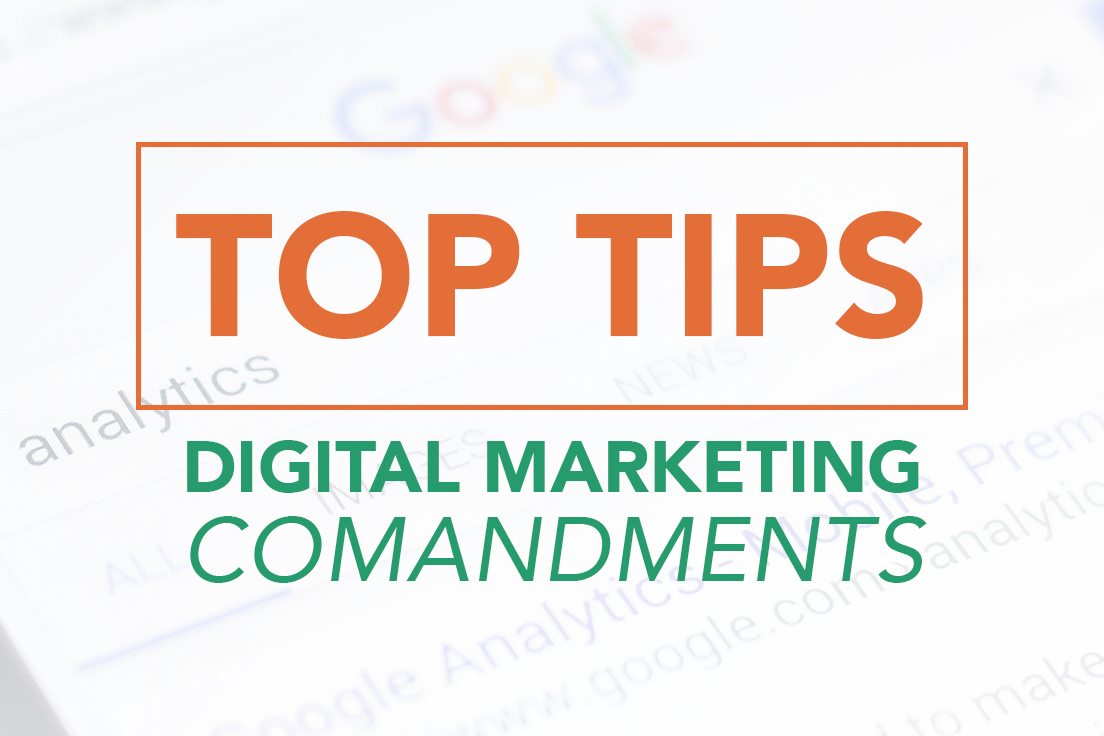The world of digital marketing can be complex and with so much advice and information out there it can be challenging to know whether you’re doing the right thing for the best results and ROI.
To help you focus on the right things that are going to help you deliver better results., The Innovation Visual team have compiled our top digital marketing tips (or commandments) to steer you in the right direction.

Don’t Stuff Your Keywords or Cannibalize
One aspect of on-site SEO is making sure that your content is relevant to particular search terms. Incorporating keywords into your website that pertain to these terms will help search engines see its value and therefore rank higher.
This can be overdone, however. Stuffing out-of-context keyword strings or lists into your site’s content or coding may seem like it would help your relevance to be recognized, but this is an old method that has been clamped down on. Search engine algorithms can’t be fooled or manipulated, and if you’re caught trying, your site’s rankings will be damaged. Make your content relevant for the user, not for search engines and you will have higher success.
Also, an important point is to not cannibalize the keywords you’re trying to target either. Keyword cannibalization is when you try and target the same keywords on multiple pages meaning you end up competing with your own content which is no go and can affect your rankings in search.
Be mobile friendly
 Due to changes in user behaviour, we have moved to a mobile-first indexing world where Google will crawl the mobile version of your site first. With that being said, making sure your website is mobile friendly is a vitally important vitally important ranking factor. Factors such as using correct hreflang tags, content, page speed and structured data all matter when it comes to being mobile friendly. To find out if pages on your website are mobile friendly, you can use this handy mobile friendly test tool from Google.
Due to changes in user behaviour, we have moved to a mobile-first indexing world where Google will crawl the mobile version of your site first. With that being said, making sure your website is mobile friendly is a vitally important vitally important ranking factor. Factors such as using correct hreflang tags, content, page speed and structured data all matter when it comes to being mobile friendly. To find out if pages on your website are mobile friendly, you can use this handy mobile friendly test tool from Google.
Page Title & Meta Description are Vital for Higher Click Through Rates
Don’t underestimate the power of your meta data. Although meta data isn’t a ranking factor, it will help to increase click through rates and traffic to your site. Make sure you take the time to write strong meta titles and descriptions for each of your website pages and be as descriptive as possible to encourage users to click through from search engine results pages.
Always be helping your visitors, not simply selling
Have a customer centric inbound marketing approach when it comes to your marketing efforts. The inbound methodology focuses on helping and educating your users to nurture them through the buyer’s journey. Focus on your users and how you are going to solve them problem, your content can’t be a thinly veiled sales pitch. Features and benefits of your product or service should come last.
Always look at paid campaigns ROI at campaign, Ad group and keyword levels
 Always measure results from your paid advertising campaigns and the overall ROI. You may be spending £50 a click but this could equate to thousands or even millions in lifetime time customer value so it’s always important to remember the value. In addition to this, take the time to regularly optimise your spend on current campaigns to see if you can get an even higher ROI.
Always measure results from your paid advertising campaigns and the overall ROI. You may be spending £50 a click but this could equate to thousands or even millions in lifetime time customer value so it’s always important to remember the value. In addition to this, take the time to regularly optimise your spend on current campaigns to see if you can get an even higher ROI.
Have the Right Call to Actions on Blogs & Landing Pages
Call to actions on your blog or landing pages can increase conversions and engagement however they need to be the right call to actions. There’s many different call to actions you could include in your content so it’s vital that you have a clear aim of what your blog or page is trying to achieve. If someone is early in the buyer’s journey, try pointing them to another piece of content whilst if they are in the decision-making stage, you could encourage them to contact for a free demo.
Write content for people, not for Google
Writing for search engines and for people is a fine balancing act. However, it’s proven that if you write for the people then you are more likely to rank well in search as content is higher quality and more relevant to the end-user.
Have Clear Marketing Objectives
Understand what your digital marketing goals are and what you are trying to achieve whether that be increased sales or leads or growth. Stay focused on what really matters and the overall objective instead of vanity/fluffy metrics. Remember to make your goals SMART – specific, measurable, attainable, realistic and timely and look at the data on a regular basis to improve results and progress.
Always Optimise your Images
 People love images and graphics but it’s important to always take the time to optimise your images properly. Image optimisation can enhance the user experience by improving page speed as well as boost your search rankings due to adding alt text attributes.
People love images and graphics but it’s important to always take the time to optimise your images properly. Image optimisation can enhance the user experience by improving page speed as well as boost your search rankings due to adding alt text attributes.
Remember how people read on websites
Most people skim read text on digital devices so keep paragraphs short and use headings that are descriptive. If users see huge paragraphs, they are likely to bounce off your website and find the information they are looking for elsewhere. Other ways to help your user read include using images to break text, bullet point lists, videos and highlighted important elements.
Make it easy for the user
You want to make your website experience as easy and seamless for the user as possible. When it comes to elements on your site, keep things obvious and accommodate users’ learned behaviours with recognisable icons and processes. Don’t put a pull handle on a push door and that’s the same with websites – don’t put a down arrow if the page then scrolls up for example!
Great user experiences = better business results through increased traffic, time on site, brand loyalty, improved SEO, increased conversions – the list goes on!
Audit your current content
Auditing your content before you plan your content strategy is a worthwhile exercise. Why waste time on creating new content when you may have perfectly good pieces already that may just need a fresh lick of paint? Content audits can help you identify strengths and weaknesses and assess where you are now in your content marketing journey.
Optimise your GMB listings
If you’re wanting to succeed at local SEO then don’t underestimate the value of Google My Business – the number 1 ranking factor for local results! It’s not enough to just have a listing however – you need to make sure you fill out it completely, update regularly with images, add posts and collect reviews.
Ad Group Best Practices
 Making sure your ad groups are set up correctly is a vital step to success. Best practices include ensuring at least two expanded ads and one responsive ad in each ad group. Decide a sensible testing period and regularly remove underperforming ads while testing against new variants.
Making sure your ad groups are set up correctly is a vital step to success. Best practices include ensuring at least two expanded ads and one responsive ad in each ad group. Decide a sensible testing period and regularly remove underperforming ads while testing against new variants.
Remember to Internally Link
Make sure internal linking opportunities are used wherever relevant, and strengthen your site with a good internal linking strategy with appropriate keyword rich anchor text used where possible. Internal linking will not only boost your SEO efforts in addition to encouraging users to stay on your site for longer and visit more pages.
Share on Social!
You’ve created great content – now it’s time to promote it! Sharing news, posts, videos and graphics on your relevant social channels can drive people to your website, increase engagement and help to increase inbound links to your site!
Looking for more top tips?
Check out the Innovation Visual blog for more digital marketing insights or if you require expert advice to grow your business through effective digital marketing, contact the Innovation Visual team.








